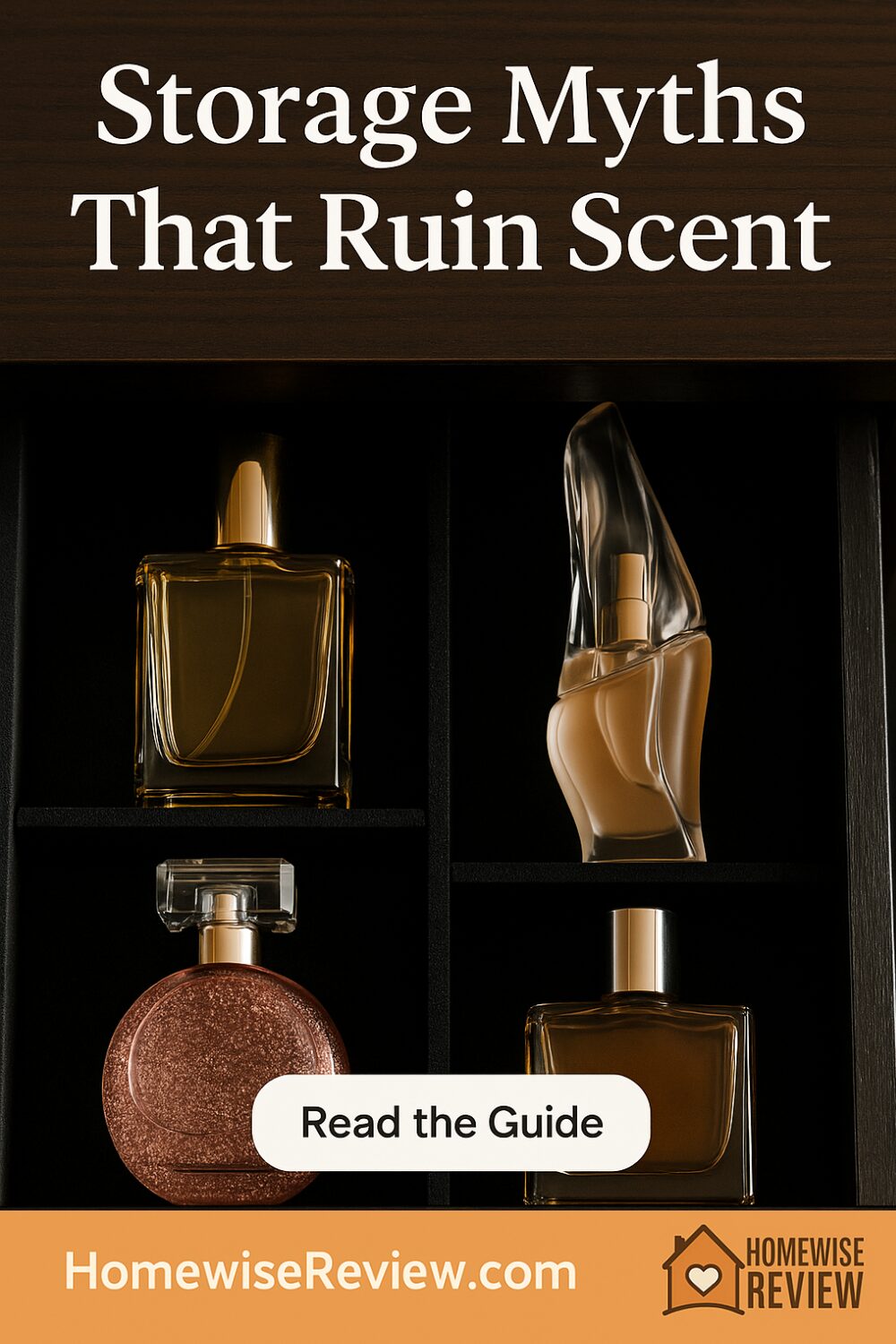
If your signature perfume goes flat in a few months or turns a strange shade on the shelf, storage is usually the culprit. Heat, light, air, and humidity all speed up oxidation and evaporation, which changes how a fragrance opens and how long it lasts. The tricky part is that a lot of popular advice sounds helpful but quietly makes things worse. Bathrooms feel convenient until steam gets inside the sprayer. Displaying bottles by a sunny window looks pretty until UV light breaks down delicate top notes. Even well-intended habits like shaking a bottle or pouring into cute travel atomizers can shorten a perfume’s life if you do them the wrong way.
This guide busts the biggest myths, explains the science in plain English, and gives you simple habits that keep your scents true to color and true to smell. Use it to protect new buys, revive your routine, and avoid accidental perfume waste.
Quick Decision Rules
- Cool, dark, dry, and steady beats warm, bright, damp, and fluctuating.
- Store upright, cap on, in a cupboard or drawer away from heat sources.
- Limit air exposure. Stick with the original atomizer.
- Avoid daily temperature swings. No car glove boxes, no sunny vanities.
Myth 1: “The bathroom cabinet is fine.”
Why it fails: Steam and humidity seep around the sprayer over time. Repeated hot-cold cycles speed oxidation and can thin the juice.
Do this instead: Keep bottles in a bedroom dresser, closet, or interior cabinet away from windows and radiators. Aim for cool, dry, and stable.
Myth 2: “Sunlight doesn’t matter for opaque bottles.”
Why it fails: UV and heat still penetrate and warm the liquid. Light breaks fragile citrus and green notes and can discolor ambers and florals.
Do this instead: Use a closed drawer or cupboard. If you display a few bottles, rotate them out and keep blinds down during bright hours.
Myth 3: “The fridge always extends shelf life.”
Why it fails: Cold can cause condensation inside the sprayer when you bring it back to room temp. Moisture plus air equals faster breakdown.
Do this instead: Only consider refrigeration for long, uninterrupted storage in a dedicated box, then let the bottle return to room temp before spraying. For everyday use, a cool, dark cabinet is safer.
Myth 4: “Shake before use to wake it up.”
Why it fails: Shaking introduces bubbles and extra air, increasing oxidation and changing how atomizers spray.
Do this instead: Gently swirl once if you must, but avoid vigorous shaking. Perfume is already blended.
Myth 5: “Decanting into any travel atomizer is harmless.”
Why it fails: Each transfer traps extra air and can shed plastic or metal residues if the atomizer is low quality or dirty.
Do this instead: Use high-quality glass atomizers with tight seals. Fill only what you will use in a few weeks. Rinse new atomizers with high-proof alcohol and let dry fully before filling.
Myth 6: “Bigger bottles are better value for everyone.”
Why it fails: If you wear a scent rarely, a large bottle spends more time aging after you open it. More headspace over time equals more oxidation.
Do this instead: Buy the smallest size you can finish within 12–24 months after first spray, especially for delicate citrus or green profiles.
Myth 7: “Leaving the cap off is no big deal.”
Why it fails: Even capped atomizers slowly exchange air; uncapped accelerates it. Evaporation and scent drift follow.
Do this instead: Replace caps immediately. Wipe the sprayer if it’s damp before capping to prevent gunk.
Myth 8: “Storing on a sunny vanity is fine in winter.”
Why it fails: Winter sun still carries UV, and radiators below windows create heat spikes that fatigue top notes and darken the juice.
Do this instead: Keep bottles several feet from windows and any heat source. Interior shelves are your friend.
Myth 9: “Horizontal storage saves space.”
Why it fails: Side-lying bottles can wet the sprayer gasket constantly, speeding evaporation and leaking.
Do this instead: Store upright. Use a shallow drawer organizer or a small bin to keep bottles steady.
Myth 10: “Perfume lasts forever if unopened.”
Why it fails: Unopened slows oxidation, but time still works on aroma molecules, dyes, and fixatives. Heat in transit or storage ages bottles on the way to you.
Do this instead: Buy from sellers with healthy turnover. Once opened, plan to enjoy the bottle within a couple of years for brightest results.
Myth 11: “Carrying a full bottle in the car is convenient.”
Why it fails: Cars swing from cold mornings to hot interiors quickly. Extreme cycles are scent killers.
Do this instead: Keep a small atomizer in your bag and bring it inside overnight.
Myth 12: “Cleaning the sprayer with water is safe.”
Why it fails: Water invites microbial growth inside the mechanism and can contaminate the juice if it seeps back.
Do this instead: If the nozzle clogs, flush with a small amount of high-proof alcohol, spray through, and let it dry fully before reuse.
Routine Starters: Set It and Forget It
- Weekly 30-second check: caps on, bottles upright, no direct light, no heat sources nearby.
- Season swap: move delicate citrus and airy florals to the darkest, coolest spot in summer.
- Travel kit: prefill one clean 5–10 ml glass atomizer per scent you will actually wear on the trip.
Quick Fixes vs Long-Term Habits
- Quick fix: rotate exposed display bottles into a drawer.
- Long-term habit: store the whole collection in one cool, dark cabinet and only display one or two at a time.
- Quick fix: toss leaky plastic atomizers.
- Long-term habit: standardize on quality glass travel sprayers and label dates filled.
Keep In Mind
- Color shifts do not always mean ruined scent, but rapid darkening usually flags heat or light exposure.
- Citrus, tea, and green scents fade fastest. Dense ambers and vanillas handle time better but will still flatten if overheated.
- If a favorite smells “off,” retire it to fabric use only and avoid direct skin until you are sure it is stable.
Final Thoughts
You do not need a wine fridge or perfect conditions to preserve your scents. A steady, cool, dark drawer plus smart habits will keep most bottles true for years. Protect from light, heat, air, and humidity, and your favorite notes will open bright and finish clean every time.
See also
Curious why some notes fade faster than others Our explainer Fragrance Notes Explained: top, heart, base and how they evolve breaks down what you smell and how oxidation changes each layer. If you want a seasonal lineup that still performs after months on the shelf, browse Best Winter Perfumes for Women for cozy picks that bloom in scarves and coats.
Planning ahead for warmer days Best Summer Perfumes for Women highlights airy choices that resist turning heavy in heat. Comparing concentration before you buy Eau de Parfum vs Eau de Toilette: What’s the Difference helps you pick the format that fits your wear pattern. And when you want to stretch your budget without hoarding giant bottles, Best Affordable Perfumes that Smell Expensive lines up value picks that still feel luxe.
FAQs
1) How long does perfume last after opening
Most bottles stay happy 1 to 3 years when stored cool, dark, dry, and upright. Delicate citrus and green scents age faster.
2) Is a mini fridge good for perfume
Only for long, uninterrupted storage in a sealed box. Everyday in-and-out use risks condensation and faster breakdown.
3) Do I need to keep the original box
It helps block light. If you have space, keep the box or use any opaque sleeve or pouch.
4) Why did my perfume turn darker
Likely light or heat exposure. It can still be wearable, but expect softer top notes and a sweeter base.
5) Are tester bottles worse for storage
Not necessarily. Testers without caps just need the same rules: cool, dark, dry, upright, and protected from light.
Affiliate Disclosure
If you purchase through links on our site, we may earn a small commission at no extra cost to you.




